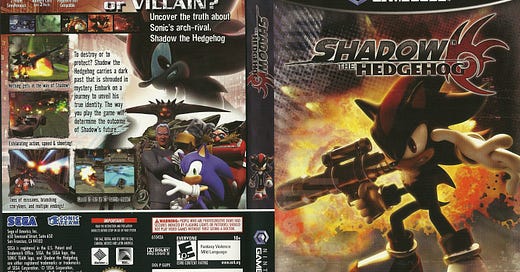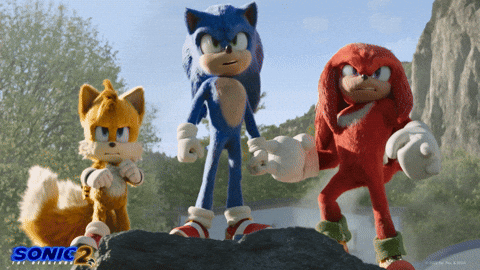⚠️ WARNING! Since Sonic the Hedgehog 3 is on Paramount+, adding spoilers about the said film on Substack, Spoutible, and/or other social media is not allowed (specifically: revealing the voice actor for the said third film, which won’t be revealed here). If you see someone adding spoilers, please, report them to the social networking sites’ officials including the Substack officials. ⚠️
Where’s that DAMN post on Substack?!
This month marks Sonic’s 34th anniversary. Today we are reviewing Shadow the Hedgehog, released in late 2005 for the Gamecube, PlayStation 2, and Xbox. It is a spin-off from the Sonic the Hedgehog series starring the character Shadow, who made his debut in Sonic Adventure 2… as he got his own video game! It follows the amnesiac Shadow’s attempts to learn about his past during an alien invasion. Gameplay is similar to previous Sonic games, featuring fast-paced platforming and ring collecting, but introduces third-person shooter and nonlinear elements. Shadow uses a variety of weapons to defeat enemies and complete missions that determine the plot and playable levels. The game’s dialogue features mild profanity, including damn and hell. The decision to include profanity and firearms was made early in development to create a more mature tone. The ESRB ultimately assigned the game an E10+ rating for “fantasy violence” and “mild language.”
Shadow the Hedgehog was the first Sonic game to use the 4Kids cast from Sonic X following the death of Doctor Eggman’s previous voice actor, Deem Bristow. This cast continued to be used until late 2010, when all but Mike Pollock were replaced before the release of Sonic Free Riders.
Sega Studios USA chose to make a game featuring Shadow to capitalize on his popularity and resolve plot mysteries that began with his introduction in Sonic Adventure 2 (2001), which we previously reviewed many moons ago, along with Sonic Adventure (1999) and Sonic Shuffle (2000), both of which were on the Dreamcast. Shadow the Hedgehog was written and directed by Takashi Iizuka and produced by Yuji Naka, with music by Jun Senoue. Iizuka strove to attract an older audience; Shadow's character allowed the team to use a darker tone and elements otherwise considered inappropriate for the series. I never owned or played the game, nor have I seen it.
Shadow the Hedgehog was revealed at the March 2005 Walk of Game (now defunct) event. It was released for the GameCube, PlayStation 2, and Xbox in Japan in November 2005 and in North America and Europe in December. It received generally unfavorable reviews from critics, who criticized its controls, mature themes, level design, and addition of guns and other weapons to traditional Sonic gameplay. However, some praised its replay value, and the game was commercially successful, selling 2.06 million copies by March 2007. The game also suffered memes such as “OW THE EDGE.” Over time, the game has developed a cult following.
The game’s official website, formerly located at http://www.sega.com/shadow (North America), is no longer available and can only be accessed through the Wayback Machine (albeit it’s not working anymore since Adobe Flash has been deprecated since early 2021), but the game’s official Japanese website, https://sonic.sega.jp/shadow/, is still active, albeit in a limited state.








